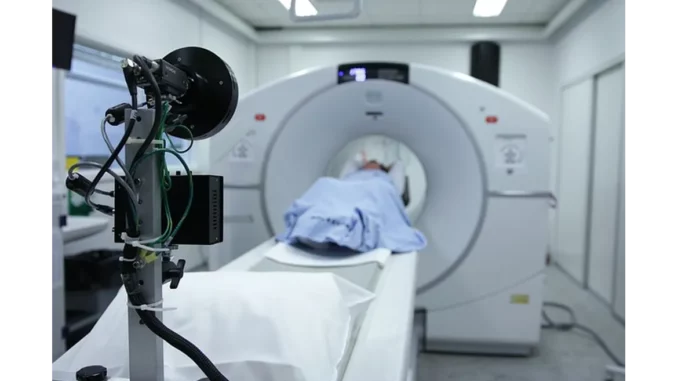
The annual RSNA (Radiological Society of North America) conference is a pivotal event for those engaged in the dynamic field of radiology. This year, the event was marked by the unveiling of Philips’ latest innovation, the CT 5300 system, which was introduced to the North American market. I had the privilege of discussing this cutting-edge technology with Dr Samantha Lewis, a distinguished radiologist who shared her insights into how these advancements are reshaping daily radiological practice.
Dr Samantha Lewis, with over a decade of experience in radiology, exuded enthusiasm for the integration of artificial intelligence in medical imaging. “We’ve long discussed AI’s potential in healthcare, but witnessing it materialise in the Philips CT 5300 is genuinely transformative,” she remarked, clearly impressed by her hands-on experience with the newly launched system. The CT 5300 is not just another piece of equipment; it represents a significant leap forward with its AI-driven smart workflow automation capabilities. Dr Lewis elaborated, “Radiology traditionally involves numerous manual tasks, from image acquisition to analysis. The CT 5300 simplifies these processes, enabling us to devote more attention to patient care instead of administrative duties.”
Our conversation delved into the collaboration between Philips and Annalise.ai, a company renowned for its expertise in advanced medical imaging AI solutions. This partnership aims to refine triage support and optimise workflows, especially in emergency departments where every moment is crucial. Dr Lewis emphasised, “In emergencies like traumatic brain injuries, time is of the essence. AI integration for flagging and prioritising critical findings can drastically reduce intervention delays.” The AI features of the CT 5300, particularly in triaging critical cases, have demonstrated a capacity to enhance median report turnaround times by up to 39%. Dr Lewis clarified, “AI doesn’t replace clinicians; it bolsters our capabilities. With the CT 5300, we aren’t just diagnosing faster; we’re diagnosing with greater intelligence.”
A standout feature of the Philips CT 5300 is its Advanced Visualisation Workspace, which offers radiologists a comprehensive suite of tools for refined image analysis. “The clarity and detail provided by this system are unmatched. It enables more precise interpretations, ultimately leading to improved patient outcomes,” Dr Lewis noted. She further discussed the practical advantages of these technological advancements, stating, “With AI managing routine tasks, we can allocate more time to complex cases requiring human expertise. This enhances our department’s overall efficiency and alleviates staff burnout.”
The collaboration with Annalise.ai introduces another intriguing development. The Annalise Critical Care AI is specifically designed to support the triage of conditions such as obstructive hydrocephalus. “The AI flags 12 time-sensitive clinical findings common in emergency settings. This is particularly beneficial during nights and weekends when staffing levels are lower,” Dr Lewis mentioned. As our conversation concluded, Dr Lewis reflected on the broader implications of these innovations for radiology’s future. “We are at a turning point where technology is enabling us to redefine patient care standards. The Philips CT 5300 exemplifies how AI can be harnessed to enhance accuracy, efficiency, and ultimately, patient outcomes,” she concluded with optimism.
For radiologists, the Philips CT 5300 signifies not merely a technological enhancement but a shift towards a more streamlined, efficient, and patient-focused approach to medical imaging. As Dr Lewis eloquently articulated, “It’s about leveraging technology to augment human abilities, not to overshadow them.” As our discussion wrapped up, it was evident that the Philips CT 5300, with its AI and smart workflow automation, is set to make a profound impact in radiology. For professionals like Dr Lewis, it’s an exhilarating time to be part of the field, witnessing firsthand the seamless integration of cutting-edge technology into routine practice.


Be the first to comment